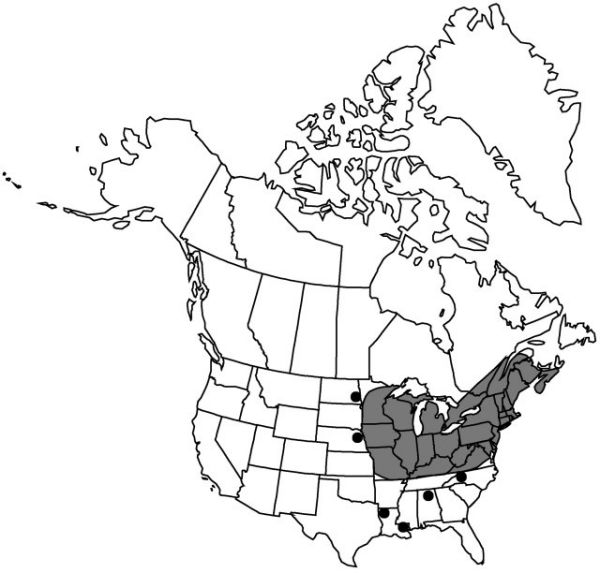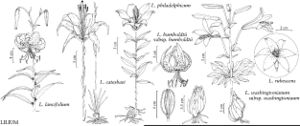Difference between revisions of "Lilium lancifolium"
Trans. Linn. Soc. London 2: 333. 1794.
FNA>Volume Importer |
FNA>Volume Importer |
||
| Line 12: | Line 12: | ||
|name=Lilium tigrinum | |name=Lilium tigrinum | ||
|authority=Ker Gawler | |authority=Ker Gawler | ||
| + | |rank=species | ||
}} | }} | ||
|hierarchy=Liliaceae;Lilium;Lilium lancifolium | |hierarchy=Liliaceae;Lilium;Lilium lancifolium | ||
| Line 38: | Line 39: | ||
-->{{#Taxon: | -->{{#Taxon: | ||
name=Lilium lancifolium | name=Lilium lancifolium | ||
| − | |||
|authority=Thunberg | |authority=Thunberg | ||
|rank=species | |rank=species | ||
| Line 54: | Line 54: | ||
|publication year=1794 | |publication year=1794 | ||
|special status= | |special status= | ||
| − | |source xml=https://jpend@bitbucket.org/aafc-mbb/fna-data-curation.git/src/ | + | |source xml=https://jpend@bitbucket.org/aafc-mbb/fna-data-curation.git/src/f50eec43f223ca0e34566be0b046453a0960e173/coarse_grained_fna_xml/V26/V26_302.xml |
|genus=Lilium | |genus=Lilium | ||
|species=Lilium lancifolium | |species=Lilium lancifolium | ||
Revision as of 21:48, 16 December 2019
Bulbs widely ovoid, 3.5(–8) × 4–8 cm, ca. 0.7–0.8 times taller than wide; scales broad, unsegmented, longest ca. 3–4 cm; stem roots usually present. Stems white-lanate, purplish, to 2 m. Buds usually flat-sided, somewhat triangular in cross section. Leaves scattered, horizontal and drooping at tips, 10–15(–18) × ca. 1.5 cm, ca. 3–6(–10) times longer than wide, distal bearing 1(–3) dark purple axillary bulbils; blade lanceolate, often narrowly so, margins not undulate, papillose, apex white-lanate, narrowly acute (rounded in distal leaves). Inflorescences racemose, 3–6(–25)-flowered. Flowers pendent, not fragrant; perianth Turk’s-cap-shaped; sepals and petals reflexed ca. 1/5–1/4 along length from base, orange with many purple-brown spots, not distinctly clawed, 7–10 × 1–2 cm, adaxial base bearing pubescent strip; sepals not ridged abaxially; stamens strongly exserted; filaments very widely spreading, diverging ca. 25° from axis; anthers purplish, ca. 2 cm; pollen rust; pistil 6–9 cm; pedicel sometimes dichotomous, stout and relatively short, to 10 cm. Capsules 3–4 cm. Seeds not counted. 2n = 24, 36.
Phenology: Flowering late summer (mid Jul–early Sep).
Habitat: Roadsides, railroad banks, near dwellings
Elevation: 0–ca. 1000 m
Distribution

N.B., N.S., Ont., Que., Ala., Conn., Del., D.C., Ill., Ind., Iowa, Ky., La., Maine, Md., Mass., Mich., Minn., Mo., Nebr., N.H., N.J., N.Y., N.C., N.Dak., Ohio, Pa., R.I., Vt., Va., W.Va., Wis., Asia (China).
Discussion
Throughout most of modern botanical history this Chinese lily has been known as Lilium tigrinum, but recent nomenclatural reassessment affirms that Thunberg’s description, published sixteen years earlier than Ker Gawler’s, applies to this species. Though many North America species are known vernacularly as tiger lilies, the name is properly applied only to this one. Along with L. candidum, it is considered to be among the earliest domesticated lilies (H. D. Woodcock and W. T. Stearn 1950), no doubt because it is handsome, easy to grow, and the bulbs are edible and substantial. It is widely planted in North America, usually as a sterile triploid that is best propagated from the bulbils.
Perhaps the hardiest garden lily, Lilium lancifolium is a widespread but sporadic garden escape, and roadside lilies near habitation in eastern and northeastern North America are often this species. Despite its general use in gardens, it seems to be naturalized only in the better-watered eastern portion of the continent.
In North America, the tiger lily is rather easily diagnosed by its truly lanceolate and widely sessile alternating leaves that bear dark bulbils on the upper stem. The mature buds are usually high-shouldered and taper rather evenly to a flattish apex with three greenish, terminal, rounded processes. No native lily consistently displays any of these features.
Selected References
None.
